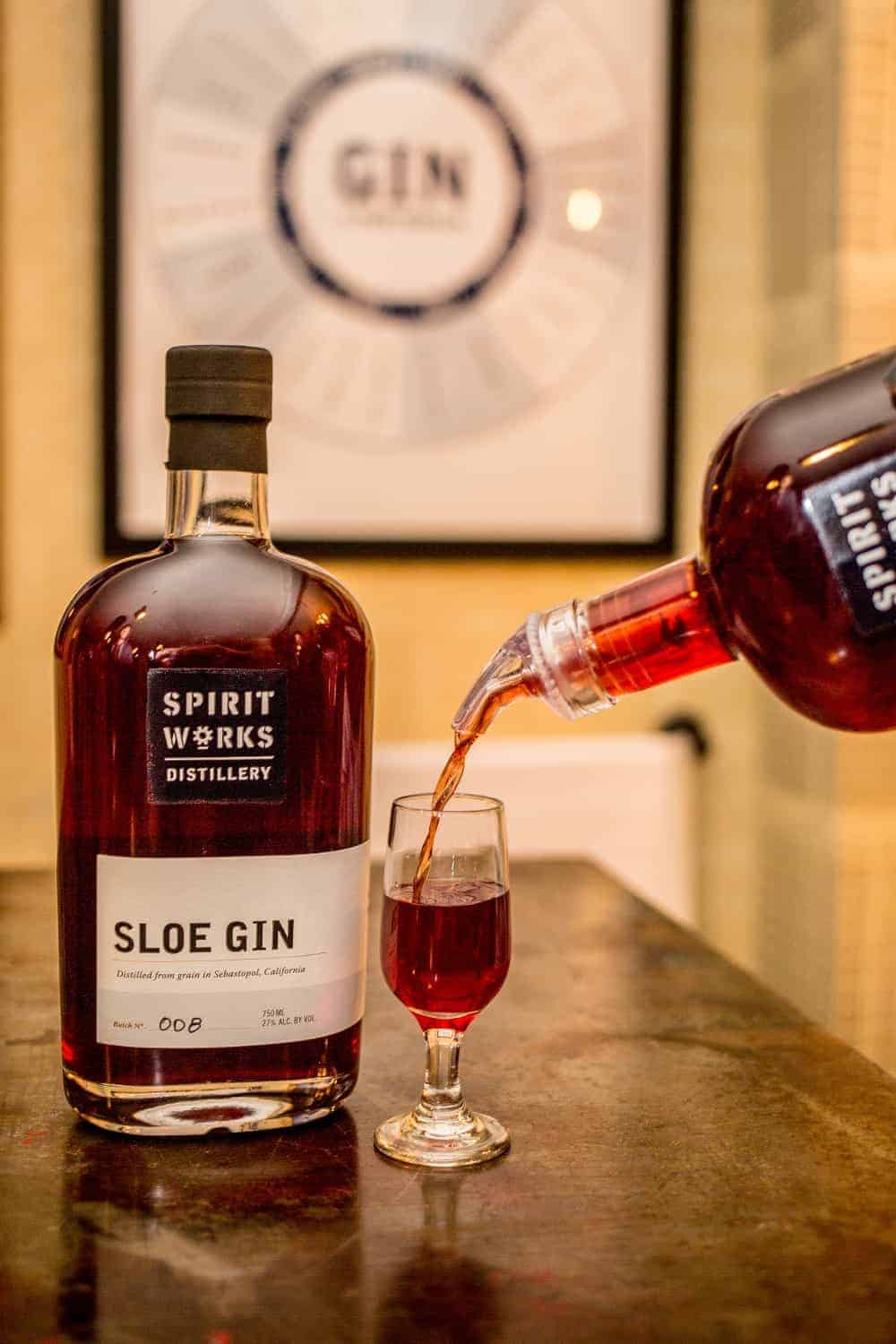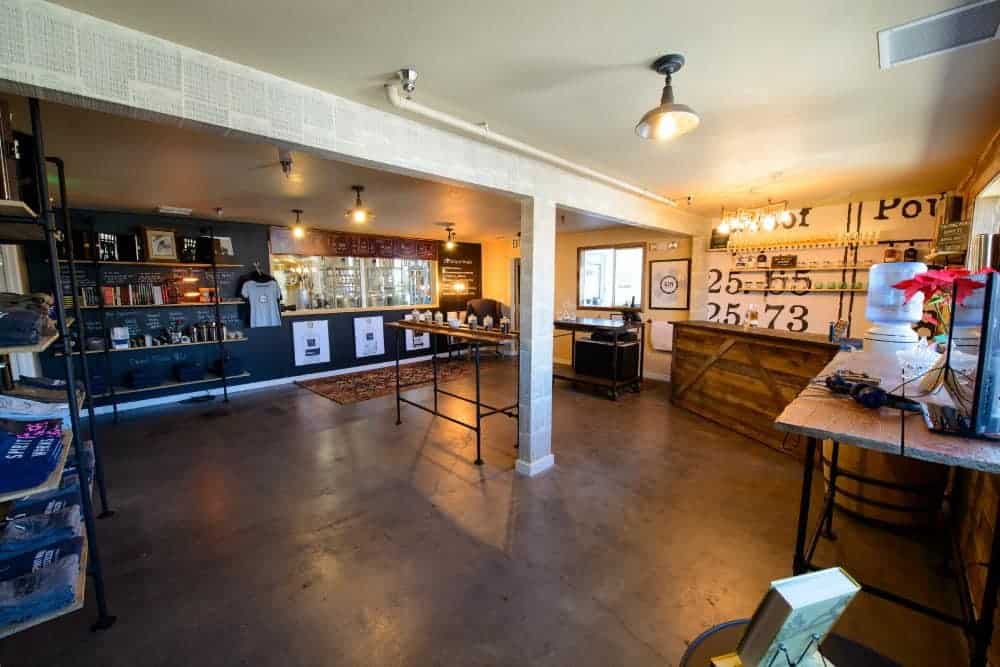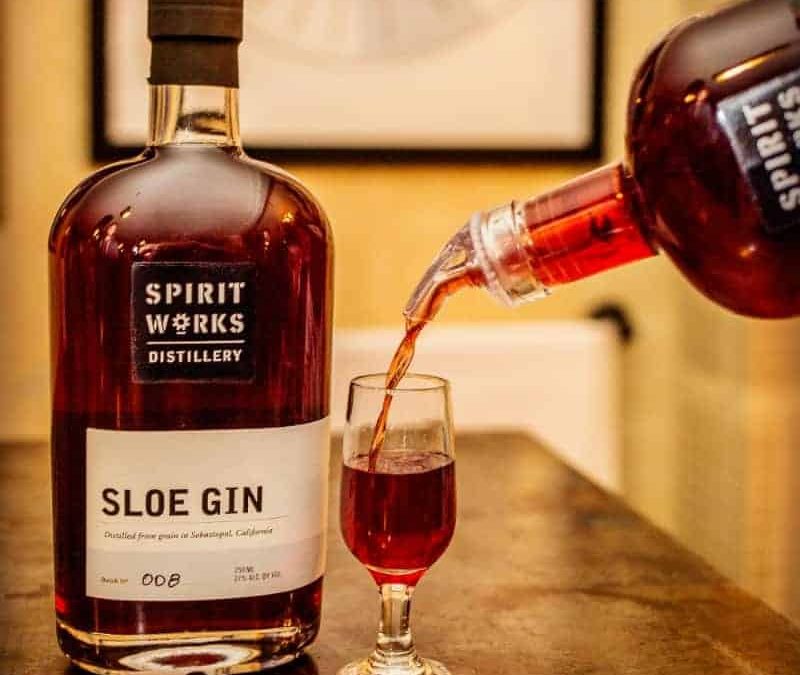
Infused in Tradition
Little-known stateside, Sloe Gin is a sweet, often homemade liqueur that’s a fairly common inhabitant of English cupboards. In a way it’s a bit like England’s version of Lemoncello – a sweet liqueur made by infusing a readily available fruit with a common spirit and sugar. Also like Limoncello, Sloe Gin recipes have been passed down for generations – sometimes kept very secret and sometimes even entered into local Sloe Gin competitions.
For Spirit Works’ co-founder Timo Marshall, the story was no different. For generations, his family spent each autumn picking sloes and slowly refining the recipe each year. In fact, the recipe was so important to the family that Timo had to be very careful when he decided to partner with his co-founder, wife, and head distiller Ashby Marshal and start the distillery. Timo always mentions that when he first moved to the US with Ashby, he was surprised and distraught at the lack of Sloe Gin available. They sought to remedy that!
“It was very important to Timo and Ashby that they respect and honor the tradition of the Sloe Gin that his family made” said Jess Shumaker, head of marketing at Spirit Works, “They went back to England and actually worked with Timo’s family to adapt their traditional recipe into the one that we use. There are some great photos of the whole family getting in on the process.”
A Time-Honored Process
Traditionally, the “recipe” for making sloe gin starts with buying a bottle of Gin from the store. But since Spirit Works actually does the whole process, starting with grain – I thought it’d be interesting to start from scratch. After getting the Sloes in the building, the process has three main steps: making the spirit base, turning that base into Gin, and then actually making that gin into the final Sloe Gin liqueur.
Sourcing the Sloes
Long before the sloes touch the gin, the Spirit Works’ team has to find and source the fruit. Historically, Blackthorn bushes (and their fruit, sloes) do not grow in the United States. They do grow in Europe and parts of Asia and Africa. To make matters more challenging, they are difficult and costly to harvest. The bushes are named “Blackthorn” due to their dark bark and prolific thorns.
Spirit Works only uses organic sloes which they source exclusively from Bulgaria. The sloes are received frozen. Traditionally Sloes are picked after the first frost because the freezing process helps break down the cellular structure of the fruit, improving their flavor. Nowadays it’s not uncommon for Sloe producers to receive the sloes frozen or freeze them after receipt for this reason.

Making the Spirit Base
Many distilleries nowadays will actually buy their base spirit from large wholesale producers, but it was important to Timo and Ashby that Spirit Works would operate as “Grain to Glass” – meaning their products come in the door as grain and undergo the full end-to-end process under their roof.
- Grains are milled (crushed) to open their husks
- The milled grains are mixed with water and “cooked” into a Mash
- Yeast is added to start the fermentation, which takes a couple of days
- After fermentation, the team will do a “stripping run”, which is an alembic distillation specifically intended to extract as much alcohol from the mash as possible. (Since they have a hybrid still, they can choose to bypass the columns during this stage of the process.)
- The resulting “low wines” are returned to the still, and a second distillation takes place, using their 26′ tall rectification column. Here they make their cuts, collecting only the hearts of the distillation.
- Water is added to bring the alcohol down to 43% ABV, and the result is either sold as Spirit Works Vodka – or it’s kept as the base spirit for making gin.
Making the Gin
The spirit base is now ready to be made into the gin, which is the base for the Sloe gin.
- First, the base spirit is returned to the still, and distilled using the alembic method (bypassing the columns.)
- Water and a mix of juniper, coriander, cardamom, angelica root, orris root, hibiscus and lemon and orange zest are either added to the pot or hung in a basket in the pot. (The team hand-zests the citrus the very same morning, which I think is why the gin has such a bright citrus quality. I say this definitely pays off!)
- A gin run will complete in one day – which is very quick compared to the milling – mashing – fermenting – stripping process which takes about a week to complete!
- The resulting Gin is watered down to bottling strength and either sold to customers, put in a barrel for their (delicious) barrel-aged gin, or saved for the last phase: infusing the sloes!

Infusing the Sloes
With the gin complete and the sloes in the building, it’s time to refer back to Timo’s family recipe. (Traditionally, families would buy their gin, not distill it themselves – I guess you could call Timo & Ashby “overachievers”!)
- Since the berries arrive frozen, the first step is to let them thaw to room temperature.
- The berries are added to the slightly-more-than-bottle-strength Gin along with sugar and allowed to macerate. The timing is proprietary but as distiller Timo likes to say, the process takes “as long as it takes.”
- Spirit Works uses a Wine Press for maximum flavor extraction from the Sloes.
- The mixture undergoes multiple filtrations to filter out the fruit.
- Finally, the Sloe Gin is bottled and sold!
The final product is truly delicious. Don’t mistake it for Gin – while it’s made with Gin, the flavor is much more of a liqueur at this point. I personally prefer the Spirit Works Sloe Gin to others on the market because they have deliberately chosen to scale back the sugar – so you can still taste some of the botanical elements of the gin alongside the tart fruitiness of the berries.
The Encore
While we haven’t mentioned it yet in this article, Spirit Works also makes Wheat and Rye whiskeys – meaning they have quite a few barrels on hand. The temptation was just too much and it wasn’t long before the Sloe Gin found its way into a barrel.
We had the opportunity to taste the Barrel Reserve Sloe Gin and I have to say, it is fantastic. The barrels seemed to calm a bit of the tartness and rounded out the flavor even more. I wouldn’t say you could taste the oak influence – thanks to the dominant flavors in the gin and from the sloes – but it really was unlike anything I’d tasted before.
This might be a fun project for anyone who owns a small barrel for aging cocktails – if you can find some Sloe Gin (or make your own), I highly recommend it!

Thank you Spirit Works Distillery!
I wanted to say an extra “Thank you” to Spirit Works Distillery and especially Jess Shumaker for taking a couple of hours out of their Sunday to give us a tour. Chris was in heaven walking around your distillery and ogling your still!
I strongly encourage readers to give Spirit Works’ Sloe gin a try – I think it’s the best that I’ve found available in our local area. It’s carried in higher end liquor shops throughout California, and non-Californians can find an order it from D&M Liquors or Bounty Hunter.
Better yet – if you find yourself anywhere near Sebastopol (only about an hour north of San Francisco), it’s absolutely worth making a trip. The distillery offers tours on Fridays, Saturdays and Sundays at 4pm, and the tasting room is open Thursday – Sunday 11am – 4pm.
If you ask VERY nicely, they might even let you taste the barrel-aged Sloe gin!





Does adding sugar and Sloes to Gin make it stronger by ABV or actually a bit weaker?
Thanks
Hey James! I’d assume it would be slightly weaker since you’d be diluting it.